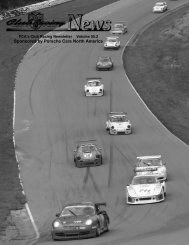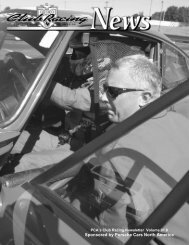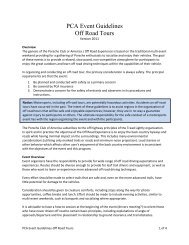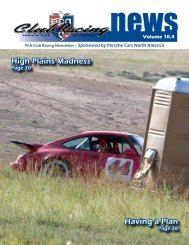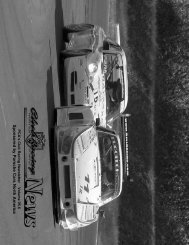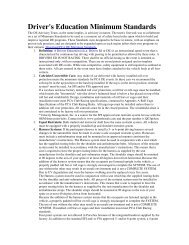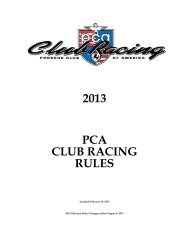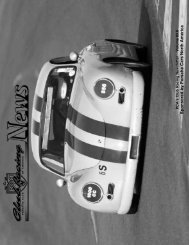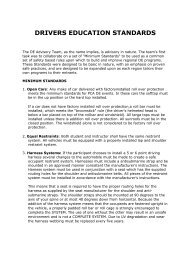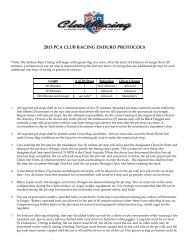2003, Volume 4 - Porsche Club of America
2003, Volume 4 - Porsche Club of America
2003, Volume 4 - Porsche Club of America
Create successful ePaper yourself
Turn your PDF publications into a flip-book with our unique Google optimized e-Paper software.
Roll Bar Blues<br />
by: Donna Amico, Chief National Scrutineer<br />
In the last few months, quite a number <strong>of</strong> potential<br />
racers have seemed confused about the roll bar requirements for<br />
stock class cars. This has resulted in the mailing and e-mailing<br />
<strong>of</strong> photos, and some disappointed folks when they were told<br />
that their roll bar will not meet PCA <strong>Club</strong> Racing<br />
requirements.<br />
It’s really quite straightforward to look at a<br />
prospective roll bar, see how it’s installed and figure out<br />
whether it will meet the PCA <strong>Club</strong> Race rule. It doesn’t take a<br />
scrutineer to do this. So, in the interest <strong>of</strong> reducing the<br />
potential aggravation caused by installing one, then having to<br />
remove it and install something different, these are the<br />
requirements and this is what to look for to meet those<br />
requirements.<br />
Appendix A <strong>of</strong> the PCA <strong>Club</strong> Racing Rules is “Roll<br />
Bar Specifications.” No one ever seems to have any problem<br />
with tubing size, or with the full-cockpit width <strong>of</strong> the bar, or<br />
with the fore/aft and cross bracing. Just about all <strong>of</strong> the<br />
confusion is with the following: “The roll bar must be securely<br />
mounted to the floor and/or longitudinal members <strong>of</strong> the<br />
unibody……The mounting area <strong>of</strong> “bolt-in” roll bars must be<br />
backed by a plate <strong>of</strong> a size equal to that <strong>of</strong> the upper mounting<br />
plate with a minimum thickness <strong>of</strong> 3/16.”<br />
So, what does this mean? The point <strong>of</strong> this is to make<br />
sure the area <strong>of</strong> the floor or unibody that supports the main<br />
hoop is sufficiently reinforced that the ends <strong>of</strong> the hoop cannot<br />
punch through the floor or body <strong>of</strong> the car. So, start by looking<br />
at the two ends at the bottom <strong>of</strong> the main hoop. If there is no<br />
mounting plate there for the bar to rest on vertically, the bar<br />
does NOT meet the requirements <strong>of</strong> PCA <strong>Club</strong> Racing. Oddly<br />
enough, there are some roll bars out there like this, and we’ve<br />
seen the pictures.<br />
Now that you’ve found a mounting plate, where and<br />
how is it designed to mount? In most cases, holes are drilled in<br />
the mounting plate, a backing plate is welded to the floor pan<br />
underneath the car, and the bar is designed to be secured with<br />
bolts through the mounting plate, floorpan, and backing plate.<br />
This is the letter <strong>of</strong> the rule, and it passes.<br />
Some years back, PCA <strong>Club</strong> Racing allowed some roll<br />
bars that did not meet the letter <strong>of</strong> the rule, but accomplished<br />
the same intent. In these, the mounting plate has no bolt holes,<br />
but rests very securely on the boxed longitudinal frame<br />
members at the door sills. There is no backing plate, but none<br />
is needed since the frame member has the structural strength to<br />
support the bar. These bars are very popular, because they do<br />
not involved welding and drilling holes in the car.<br />
So, if there are no holes in the mounting area that<br />
supports the main hoop, then take a look at what it rests on.<br />
Does it rest on the longitudinal frame member? If so, then yes,<br />
it meets our requirements. If it just rests on the floor pan, or on<br />
the sheet metal <strong>of</strong> the wheel well, it does NOT pass, and you<br />
must use a different type <strong>of</strong> roll bar.<br />
Roll bars that do not have vertical supports for the<br />
ends <strong>of</strong> the main hoop rely on horizontal bolts that bolt the bar<br />
to a seat belt mount for support <strong>of</strong> the hoop in a rollover.<br />
Regardless <strong>of</strong> various arguments on the shear strength <strong>of</strong><br />
various grades <strong>of</strong> bolts, I don’t know <strong>of</strong> a racing sanctioning<br />
body that considers horizontal attachment points to be<br />
sufficient for roll bars or cages. In fact, PCA <strong>Club</strong> Racing<br />
seems unusual in allowing roll bars at all, most seem to require<br />
a roll cage. However, one <strong>of</strong> the “guiding principles” <strong>of</strong> PCA<br />
<strong>Club</strong> Racing is that we allow and encourage participation from<br />
cars that are driven to and from the track, and few <strong>of</strong> us would<br />
want a roll cage in our street cars.<br />
One last reminder: roll bars are only acceptable for<br />
cars running in their stock class, and for GT-6. Cars running as<br />
“prepared” in a stock class, all GT-1 through GT-5 cars, and<br />
GTC cars must all have a roll cage.<br />
The Racer’s Group entry qualified 2nd in class and<br />
showed much promise in the early hours <strong>of</strong> the 24 Hours<br />
<strong>of</strong> Le Mans. Unfortunately, mechanical woes set them<br />
back multiple laps. Despite the setback, The Racer’s<br />
Group entry pressed on and finished a very respectable<br />
fifth in class. Those who watched the race would know<br />
that The Racer’s Group entry carried the PCA <strong>Club</strong><br />
Racing logo on the leading edge <strong>of</strong> the front hood. In<br />
the picture to the left, during a routine pit stop, one can<br />
see the “Crescent” sponsorship draped on the right front<br />
fender. Crescent City <strong>Porsche</strong> is based in New Orleans<br />
and is a sponsor <strong>of</strong> PCA <strong>Club</strong> Racing.<br />
6 CRN July/August <strong>2003</strong>



